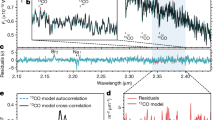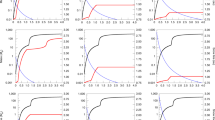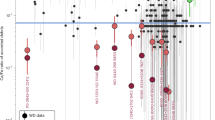Abstract
The four giant planets in the Solar System have abundances of ‘metals’ (elements heavier than helium), relative to hydrogen, that are much higher than observed in the Sun. In order to explain this, all models for the formation of these planets rely on an influx of solid planetesimals17. It is generally assumed that these planetesimals were similar, if not identical, to the comets from the Oort cloud that we see today. Comets that formed in the region of the giant planets should not have contained much neon, argon and nitrogen, because the temperatures were too high for these volatile gases to be trapped effectively in ice. This means that the abundances of those elements on the giant planets should be approximately solar. Here we show that argon, krypton and xenon in Jupiter's atmosphere are enriched to the same extent as the other heavy elements, which suggests that the planetesimals carrying these elements must have formed at temperatures lower than predicted by present models of giant-planet formation.
This is a preview of subscription content, access via your institution
Access options
Subscribe to this journal
Receive 51 print issues and online access
$199.00 per year
only $3.90 per issue
Buy this article
- Purchase on Springer Link
- Instant access to full article PDF
Prices may be subject to local taxes which are calculated during checkout

Similar content being viewed by others
References
Mahaffy,P. R., Donahue,T. M., Atreya,S. K., Owen,T. & Niemann,H. B. in Primordial Nuclei and their Galactic Evolution (eds Prantzos, N., Tosi, M. & von Steiger, R.) 239–250 (Kluwer, Dordrecht, 1998).
Mahaffy,P. R., Niemann,H. B., Alpert,A., Atreya,S. K., Donahue,T. M. & Owen,T. Heavy noble gases in the atmosphere of Jupiter. Bull. Am. Astron. Soc. 30, 1066 (1998).
Niemann,H. et al. The composition of the Jovian atmosphere as determined by the Galileo probe mass spectrometer. J. Geophys. Res. 103, 22831–22845 (1998).
Roulston,M. S. & Stevenson,D. J. Preduction of neon depletion in Jupiter's atmosphere (abstract). Eos 76, F343 (1995).
de Pater,I. & Massie,S. T. Models of the millimeter-centimeter spectra of the giant planets. Icarus 62, 143–171 (1985).
de Pater,I. Jupiter's zone-belt structure at radio wavelengths. Icarus 68, 344–365 (1986).
Joiner,J. & Steffes,P. B. Modelling of Jupiter's millimeter wave emission utilizing laboratory measurements of ammonia (NH3) opacity. J. Geophys. Res. 96, 17463–17470 (1991).
Romani,P. N., de Pater,I. & Zahnle,K. Galileo, SL9 and Jupiter's deep atmosphere. Bull. Am. Astron. Soc. 27, 81 (1995).
Folkner,W. M., Woo,R. & Nandi,S. Ammonia abundance in Jupiter's atmosphere derived from attenuation of the Galileo probe's radio signal. J. Geophys. Res. 103, 22847–22856 (1998).
Anders,E. & Grevesse,N. Abundances of the elements: Meteoritic and solar. Geochim. Cosmochim. Acta. 53, 197–214 (1989).
Atreya,S. K., Wong,M. H., Owen,T., Mahaffy,P. R., Niemann,H., de Pater,I., Drossart,P. & Encreanz,Th. A comparison of the atmosphere of Jupiter and Saturn: Deep atmospheric composition, cloud structure, vertical mixing and origin. Planet. Space Sci. (in the press).
Owen,T. & Bar-Nun,A. Comets, impacts and atmospheres. Icarus 116, 215–226 (1995).
Bar-Nun,A., Kleinfeld,I. & Kochavi,E. Trapping of gas mixtures by amorphous water ice. Phys. Rev. B 38, 7749–7754 (1988).
Cassen,P. Utilitarian models of the solar nebula. Icarus 112, 405–429 (1994).
Linke,R. A., Guelin,M. & Langer,W. O. Detection of H15 NN+ and HN15 N+ in interstellar clouds. Astrophys. J. 271, L85–L88 (1983).
Womack,M., Wyckhoff,S. & Ziurys,L. M. Observational constraints on Solar Nebula nitrogen chemistry: N2/NH3. Astrophys. J. 401, 728–735 (1992).
Van Dishoeck,E. F., Blake,G. A., Draine,B. T. & Lunine,J. I. in Protostars and Planets III (eds Levy, E. H. & Lunine, J. I.) 163–244 (Univ. Arizona Press, Tucson, 1993).
Geiss,J. Composition of Halley's Comet: Clues to origin and history of cometary matter. Rev. Modern Astron. 1, 1–27 (1988).
Krankowsky,D. in Comets in the Post-Halley Era (eds Newburn, R. L. Jr, Neugebauer, M. & Rahe, J.) 855–878 (Kluwer, Dordrecht, 1991).
Wyckoff,S., Tegler,S. C. & Engel,L. Nitrogen abundance in Comet Halley. Astrophys. J. 367, 641–648 (1991).
Owen,T., Atreya,S. K., Mahaffy,P., Niemann,H. B. & Wong,M. H. in Three Galileos: The Man, The Spacecraft, The Telescope (eds Barbieri, C., Rahe, J., Johnson, T. V. & Sohus, A.) 289–297 (Kluwer, Dordrecht, 1997).
Atreya,S. K., Owen,T. C., Wong,M. H., Niemann,H. B. & Mahaffy,P. R. in Three Galileos: The Man, The Spacecraft, The Telescope (eds Barbieri, C., Rahe, J., Johnson, T. V. & Sohus, A.) 289–297 (Kluwer, Dordrecht, 1997).
Showman,A. P. & Ingersoll,A. P. Interpretation of Galileo Probe data and implications for Jupiter's dry downdrafts. Icarus 132, 205–220 (1998).
Marten,A. et al. First observations of CO and HCN on Neptune and Uranus at millimeter wavelengths and their implications for atmospheric chemistry. Astrophys. J. 406, 285–297 (1993).
Acknowledgements
We thank NASA for supporting this research.
Author information
Authors and Affiliations
Corresponding author
Rights and permissions
About this article
Cite this article
Owen, T., Mahaffy, P., Niemann, H. et al. A low-temperature origin for the planetesimals that formed Jupiter. Nature 402, 269–270 (1999). https://doi.org/10.1038/46232
Received:
Accepted:
Issue Date:
DOI: https://doi.org/10.1038/46232
This article is cited by
-
The Deep Oxygen Abundance in Solar System Giant Planets, with a New Derivation for Saturn
Space Science Reviews (2024)
-
Atmospheric Science Questions for a Uranian Probe
Space Science Reviews (2024)
-
A subsolar oxygen abundance or a radiative region deep in Jupiter revealed by thermochemical modelling
Nature Astronomy (2023)
-
In Situ exploration of the giant planets
Experimental Astronomy (2022)
-
Quadrupole Ion Trap Mass Spectrometer for Ice Giant Atmospheres Exploration
Space Science Reviews (2021)
Comments
By submitting a comment you agree to abide by our Terms and Community Guidelines. If you find something abusive or that does not comply with our terms or guidelines please flag it as inappropriate.



